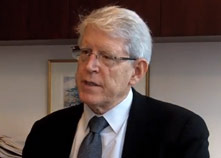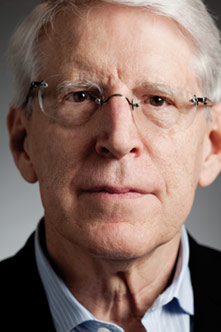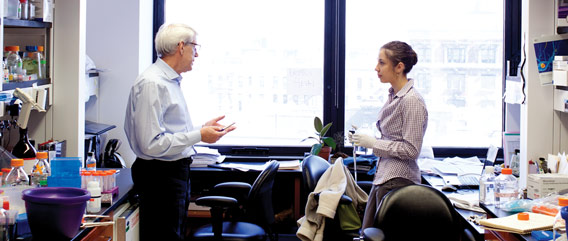Two Careers in One

In the 1990s, Tom Maniatis was already well known as one of the world’s experts on the mechanisms of gene regulation. He had pioneered gene-cloning methods two decades earlier and co-authored a 1982 three-volume manual still considered “the bible” of molecular cloning. He had been the first to isolate and clone a human gene and use it to find mutations that cause disease. He helped launch the biopharmaceutical industry by co-founding Genetics Institute, one of the first companies of its kind. The accomplished scientist was professor and chair of the Department of Molecular and Cellular Biology at Harvard.
But then something happened that would focus his research in a new direction. It would also set him on a path that led to P&S, where he is now the Isidore S. Edelman Professor and Chair of the Department of Biochemistry & Molecular Biophysics.
In 1996, Dr. Maniatis’ sister, Carol, a grandmother, mother of four, and active 50-year-old who spent weekends in the mountains near her home in Colorado, where Dr. Maniatis also had been born and raised, began experiencing weakness in her legs. Soon, she was diagnosed with amyotrophic lateral sclerosis, the neurodegenerative disease that destroys motor neurons in the brain and spinal cord while leaving sensory and cortical neurons untouched. “Her next and final two years were an unimaginable nightmare for everyone close to her,” he told a U.S. Senate subcommittee in 2000, just a year after her death. “She was ultimately reduced to a limp and lifeless body with a perfectly good mind inside … unable to express the complicated emotions one must feel while the most fundamental human activities are relentlessly taken from you day by day. At least with most other diseases, it is possible to express the feeling of sadness and the fear of dying and to be comforted in a meaningful way.”
Soon after his sister’s diagnosis, Dr. Maniatis was contacted by the ALS Association, which asked him to do something that was, at the time, rather unusual: Bring together a group of basic scientists who could identify new directions for ALS research. He was eager to do so, and for several years he chaired the committee and helped steer the research of others. But he did not immediately begin to work on ALS-related investigations in his lab, he says, “because I could not see how I could directly contribute. I’m not a neuroscientist—or wasn’t.”
With approximately 5,600 people diagnosed with ALS each year in the United States, its frequency of occurrence is similar to multiple sclerosis but its overall patient population is much lower, making the disease less well known. It is almost always fatal; most people diagnosed with ALS live, on average, only three to five years. When Dr. Maniatis’ sister was diagnosed, that life expectancy had not changed since the disease was first mentioned in medical literature in 1869.
Many genes implicated in ALS play a critical role in RNA transcription, processing, and transport, so research is focused on determining whether RNA metabolism causes the disease or is a secondary effect.
Joining the ALS Association’s research committee came at a propitious time for a new focus on the disease. In 1993 scientists had identified the first gene, SOD1, the cause of a familial form of ALS, and the tools of genome sequencing, some of which were developed by Dr. Maniatis, were becoming available. Since then, the committee has been and continues to be active and productive, says Dr. Maniatis. “It really did introduce into the ALS research community a different direction and a different way of thinking.” During the past decade, he adds, “ALS has risen from the backwater of neurological research to the forefront. In many ways, it’s a better defined disease than other neurodegenerative diseases such as Alzheimer’s and Parkinson’s.”
Genetic studies have now identified a dozen genes involved in ALS, and much progress has been made in the use of embryonic stem cells, due in large part to the work of Thomas M. Jessell, the Claire Tow Professor of Motor Neuron Disorders in Neuroscience and professor of biochemistry & molecular biophysics at P&S. In 2002 the Jessell lab developed methods for transforming embryonic stem cells into motor neurons, a milestone that proved important in Dr. Maniatis’ transition from ALS advocacy to ALS research.

Title: Isidore S. Edelman Professor and Chair, Department of Biochemistry & Molecular Biophysics
Education: PhD in molecular biology from Vanderbilt University, bachelor’s and master’s degrees from the University of Colorado
Postdoc training: Harvard and the Medical Research Council Laboratory of Molecular Biology in Cambridge, England
Member: Institute of Medicine, National Academy of Sciences, American Academy of Arts and Sciences, American Academy of Microbiology, and American Association for the Advancement of Science
Notable awards: Lasker-Koshland Special Achievement Award in Medical Science, Donald Mulder Award for ALS research from the ALS Association, honorary PhDs from the Watson School of Biological Sciences at Cold Spring Harbor Laboratory and the University of Athens in Greece, Scientific Achievement Award from the American Medical Association, Eli Lilly Research Award in Microbiology and Immunology from the American Society of Microbiology, Novartis Drew Award in Biomedical Research, and Richard Lounsbery Award for Biology and Medicine from the U.S. and French national academies of science
Life before P&S: Harvard department chair (Department of Molecular and Cellular Biology) for 25 years and professor for 30 years, research position at Cold Spring Harbor Laboratory, and faculty position at California Institute of Technology
“When we realized that we could use mouse embryonic stem cells to study ALS,” Dr. Maniatis says, “it provided an opening for me because now I could actually use the tools and the directions that I have always used in basic research to begin to understand ALS disease mechanisms.” He began working on ALS in his lab at Harvard in 2006 and in 2010 moved to P&S, drawn by what he calls Columbia’s “extraordinary commitment to ALS” through the recruitment of researchers, establishment of the Motor Neuron Center, and access to a large patient population.
At P&S, his lab compares motor neurons generated from mouse embryonic stem cells with those from induced pluripotent stem cells generated from fibroblasts, or skin cells, of patients with ALS, a technique used for the first time in 2008 in a collaboration between a team of scientists at Columbia’s Motor Neuron Center and Kevin Eggan, PhD, at the Harvard Stem Cell Institute. Taking advantage of revolutionary advances in sequencing technology, Dr. Maniatis and other researchers are collecting massive amounts of RNA sequencing data from both mouse models and human patients and searching across the database for the hallmark commonality in ALS disease mechanism.
One of the early research goals the ALS Association research committee identified was the need to determine whether ALS was motor neuron specific or if other cells were factors. About five years ago, Dr. Maniatis (then collaborating with Dr. Eggan at Harvard) and Serge Przedborski, MD, PhD, co-director of the Motor Neuron Center at Columbia, determined that other cells do contribute to the disease. One such cell is the astrocyte—the star-shaped glial cells of the nervous system. “Astrocytes play an absolutely essential function in motor neuron viability,” says Dr. Maniatis. “They nurture the neurons, feed them, and control electrical activity.”
Both the Maniatis and Przedborski labs independently found that when astrocytes carrying mutant forms of SOD1 are co-cultured with normal motor neurons, the astrocytes release a toxic factor that kills the motor neurons. Last year, a team at Ohio State University showed the same results using human astrocytes generated from ALS patients with either the familial form of the disease, which makes up only about 5 percent to 10 percent of cases, and patients with the non-inherited sporadic form of ALS. “It’s now clear that in both the human disease and in the mouse model, the interplay between astrocyte and motor neurons is critical in the disease,” says Dr. Maniatis. Much of Dr. Maniatis’ work, and that of Dr. Przedborski at Columbia, is directed toward identifying the products astrocytes release that adversely affect motor neuron viability.
In searching for ways in which astrocytes trigger cell death in motor neurons, the Maniatis lab, in a study performed by Hemali Phatnani, PhD, associate research scientist, has found that astrocytes and motor neurons communicate with each other in a complex genetic interplay that is “profoundly disrupted” in ALS, as the team writes in a paper published in February in the Proceedings of the National Academy of Sciences. This finding strengthens the case for the central role astrocytes play in the disease process and provides a catalog of aberrant cellular pathways to explore for new drug targets.
In other research, two members of the Maniatis lab, in collaboration with Dr. Jessell, have identified a new pathway that involves inflammation, a fortuitous connection to Dr. Maniatis’ longtime investigation into innate immunity and inflammation. “It’s made it possible to move quickly in this area, and we’ve identified a secreted molecule, a cytokine, from astrocytes that triggers the activation of a whole series of genes that lead to the death of motor neurons,” he says. Researchers are now at work to design ways to inhibit that molecule.
While no consensus yet exists about what the cellular mechanism for ALS might be, Dr. Maniatis sees two major themes emerging. One has to do with protein aggregation—like the plaques associated with Alzheimer’s disease. Two important genes, TDP-43 and FUS, which can form large aggregates, were identified about six years ago in patients with familial ALS. And last year, in what Dr. Maniatis calls a “major breakthrough,” researchers conducting genome-wide linkage analysis of individuals with sporadic ALS found de novo, or spontaneously occurring, mutations of TDP-43 and FUS, the same mutations seen in patients with the inherited form of the disease. (This trend is emerging across neuroscience, Dr. Maniatis notes, as it has become clear that individuals each carry as many as 200 mutations that are not shared among family members but that occurred during human germ cell development, in the process of reproduction.) “That’s a central theme in ALS disease mechanism, the fact that you have these highly abundant, ubiquitous proteins that are prone to aggregation and the mutant proteins form large aggregates that are associated with the death of the motor neurons.”

This process of deregulated aggregation could explain the late onset of the disease, which is diagnosed in patients, on average, at age 55. “During the life of an individual, there’s a constant battle between the formation of aggregates and their dissolution,” he says. In fact, on the opposite end of the spectrum, a number of other genes implicated in familial ALS reside in proteins whose job it is to clear aggregates. “What’s emerging is a very complex picture of these two forces acting in a delicate balance over the course of a lifetime battle; in ALS the aggregates win.”
The second important theme associated with ALS is RNA metabolism. A number of genes implicated in the disease play a critical role in RNA transcription, processing, and transport, and a key goal now is to determine whether the effects of RNA metabolism are secondary to the aggregation or if the RNA metabolism effect itself is causing the disease. “That’s where most of the work in the field is headed right now,” says Dr. Maniatis, who earlier in his career made major contributions to the RNA field.
The poignancy of the realization that the methods Dr. Maniatis himself pioneered and the work he has done over decades may hold keys to developing therapies to fight the disease that took his sister’s life resonates in the air, powerful but unspoken. Sitting in his office overlooking the Hudson River, he lowers his voice a bit as he explains that ALS is, truly, one of the worst diseases a person can succumb to.
But when describing the numerous advances being made at Columbia and elsewhere in the effort to understand ALS, a joyful excitement returns to his demeanor. And it is no different from that he shows for other areas of research his lab pursues. He is particularly pleased, for example, about his lab’s work on the expression and function of protocadherin genes and their potential connection to autism. These genes are adhesion proteins on the cell surface, and his lab has discovered that they, in essence, “provide a bar code for every cell, so every neuron can distinguish itself from other neurons,” he explains. When these proteins are mutated, a neuron’s dendrites are unable to tell self from non-self, so instead of making the synaptic connection and repulsion with other dendrites that are crucial for proper functioning of the neural circuitry, the dendrites with mutated protocadherin proteins clump together. He turns to his computer and shows the remarkable image of this happening. And then he adds, with palpable excitement, that his lab just received its first grant to study the role of these genes in autism.
- Log in to post comments


